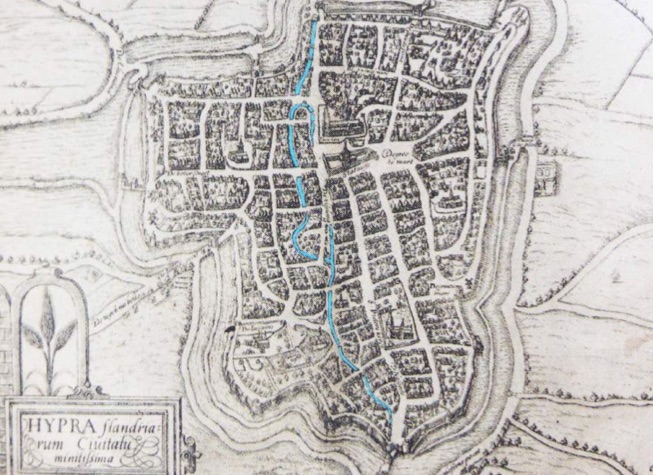ACADEMIC YEAR 2022-2023
Campus Sint-Lucas Ghent
ENGAGEMENT LEGACY
ADO: Restoring Broken Journeys #4
English
Tutor: Gisèle Gantois
URBAN RESILIENCE AFTER DISASTER – HINGE: YPRES
Key words: Palimpsest, Urban Resilience, Lived Space, Heritage and Inheritance, Regeneration
Picture: Cartes Parlantes: The city of Ypres – The Ghost Client
Highlighting historical information confronted with experiences from the ground gathered while walking. Course of the underground river Ieperlee. Original map: anonymous copper engraving from 1581 after Braun and Hagenberg in ‘Descrittione’ by Ludovico Guicciardini in Vanrolleghem (2006: 62-63)
Jim Du Pan, ‘’Ypres’ secrets’, master thesis: p.30, International Master, Faculty of Architecture – KU Leuven – Academic Year 2016-2017
STUDIO ASSIGNMENT
Site
Ypres town, situated in the Flemish province of West-Flanders was completely destroyed during the First World War (1914-1918). When seeing the photographs made during and after the war, we might think of a tabula rasa caused by the bombing. However, what is remarkable is that specifically the streets, alleys and public spaces lined by the blackened ruins remained visible because trucks and tanks run over them and people who came back after the war cleared them from rubble and re-walked them again and again. This pattern of public and collective spaces is still recognisable today in this palimpsestic town’s spatial composition. While on the one hand palimpsest is a powerful term referring to geological stratification, palimpsest is also a literary metaphor. This reference to language or to think of the landscape or city as text or using methods of analysis that relate closely to literary practices comes back regularly in urban studies, but perhaps most famously in Michel De Certau’s The Practice of Everyday Life (1984) in which spatial narratives and acts of reading and writing are used to describe experiences in the city. Andreas Huyssen’s (2003) concept of “urban palimpsest” translates his conviction that literary techniques of reading historically, intertextually, constructively and deconstructively at the same time can be woven into our understanding of urban spaces as lived spaces that shape our collective imaginaries’ (Huyssen 2003, 7) In this sense palimpsest is considered as a less rectilinear, less straightforward development: here the layers of the palimpsest are rather thin, frail and mostly unfinished, fragments of different layers peek through other newer layers. In André Corboz’s (1983) definition the re-inscription of the palimpsest involves not only the adding of new layers but more often than not the erasure or adaptation of the old ones.
Goals
This exercise aims to investigate how ordinary citizens with their real-life experiences interfere in top-down made proposals while enabling the co-creation of a resilient palimpsestic town in contrast with the predominant discourse on the war’s destruction and the reconstruction. From here those elements will be distilled, supported with intense fieldwork that will be helpful to understand the town’s multilayered appearance today while unraveling and highlighting its spatial fabric. Bridges will be made to actual cases of urban resilience after disaster. Questions will be formulated about whether and how the historical spatial configuration contributes to the process of recovery after disaster.
Expected outcome
The basis of this real-life case is intense fieldwork with the Interactive Walking method developed by the author (G.G.). This will result in graphical representations on small and large scale and in tactile models going from the very small scale to 1:1 installations on site representing the multi-layered city.
KEYWORDS
Social sustainability, Interactive, Collective Space, Local Identity, Appropriation, Social Meshwork, Community, Community Based Approaches, Storytelling, Palimpsest, Resilient Environments, Cultural Landscape, Recovery, Regeneration
Please read the full studio description here.

